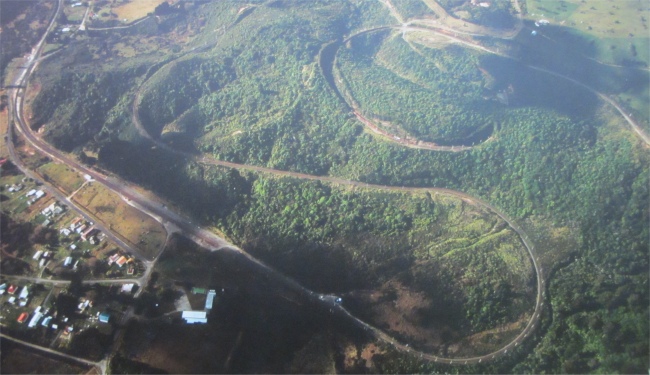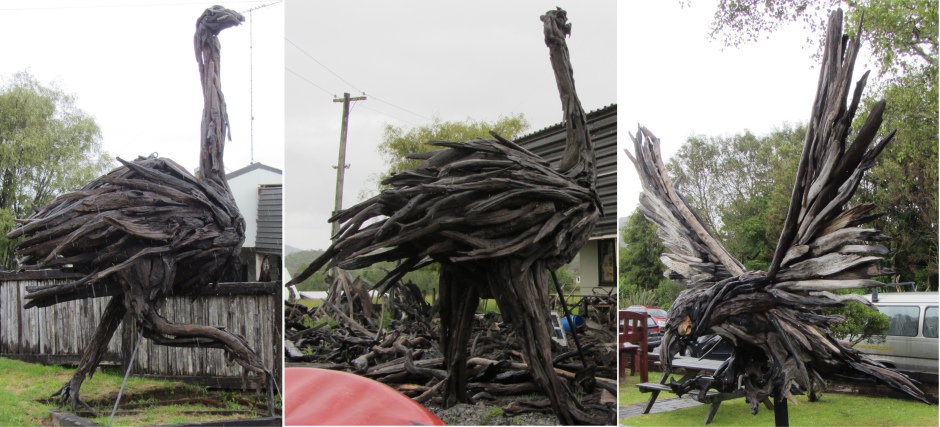 Aerial Photo of Raurimu Spiral |
Mel then told me about the dinosaur sculpture a hundred metres or so from the lookout. "Jack, a British bloke, came over a few years ago and spent five days travelling down the river. He fell in love with the place and decided he wanted to stay. He tried to get a job, but there was nothing going. Then he decided to make a sculpture out of driftwood. He had no previous experience, but he made rather a good job of it. That was his first, the dinosaur. If you walk further up the hill towards the lodge, you'll see a few more standing there."
"Would you like to see our museum?" she asked, "It's just next door." "Sure," I replied. "I'll get someone to come and open it up for you," and off she went to make a quick call. "I understand there is a model railway layout upstairs," I probed on her return. "There is, not many people know about that. There are only three enthusiasts involved with it now. I'll see if one is free to come over and show you around." Again she went off to make a call.
While we were waiting for these persons to turn up, Mel made me coffee and we chatted for quite a while. Mel was a very friendly and extremely helpful lady. She had come over to New Zealand with her husband, Dave, from Leicester over forty years ago, and they both adored the country. Dave popped in and I learned that he had worked on trucks delivering to Felixstowe in the late 60s. He then migrated onto JCBs, and brought that skill set across to his new home, and transferred those skills into the logging industry. The couple had recently returned to Mel's home town, and she was saddened to find that an area she knew well all those years ago was now a now go area. She had unwittingly entered the area to find she was being cursed and spat at. I guess she was unaware of how racial tensions had changed over the last forty years.
We chatted about our respective countries, our families (she was touched by my family photo I showed her), our travels and our plans for Christmas, or in my case lack of plans. She and her family were all going up to a place they own in the Coromandel for Christmas. " A very nice area too," I said. "I will be visiting the Karangahake Gorge next February. There is a connection there with the village I grew up in," I added.
At that point Len Goodwin arrived, a tall elderly man, softly spoken, with a self-assured smile and a kind eye. He had personally arrived to give me a one-on-one guided tour of the museum. Many small town museums work on an "Open by Appointment" basis, and are run on a shoestring by volunteers. Len was such a volunteer. The old station building, in which the museum was located, had been derelict. The deal struck was that the museum does the building up and pays $60 per year for the lease, and the rail company would provide the power for free.
Len's father had wanted him to join him in the garage business, but Len was single minded and wanted to work on the railways. He had progressed through being a train driver to the dizzy heights of level 5 rail engineer, a position of importance and responsibility.
The museum was primarily focussed on the local Taumarunui railways, its engineering and its people. A small section was devoted to the sawmill industry. Most of the items on display were donated, and much of it was pretty unique to the area.
Len led me from padlocked room to padlocked room. I saw ancient electrical instruments, steam pressure gauges, signalling equipment, tools, engineering drawings, photographs, posters, uniforms, engine number plates ...... the list is endless. A lot of the hardware had come from Britain, in fact Len could talk for hours on where the odds and sods had all originated from. He informed me all about the locomotives that came from Britain, USA, Italy and Japan; their strengths and weaknesses, the political purchasing decisions (the company had screwed up big time on a couple of occasions). I learned all about the different country's steels used in making wheels and lines, and the merits of each. Even the coal used was an art in itself; British made boilers had to be modified to suit the poor coal that was being used in New Zealand. There was nothing that this guy didn't know, he was a real fountain of wisdom, enthusiastic, but didn't ram it down my throat. He preferred guys like me popping in for interest's sake, rather than the railway buffs who knew it all.
I chatted with him about the proposal put forward by the entrepreneur to use modified golf buggies on the spare line down to Stratford. He had heard about it but had his doubts that it would ever work. "There is a similar setup already working, but on flat country where the rail maintenance is virtually nil," he said. "However, with this new route, the terrain is very rugged with lots of tunnels. The area is prone to land slips. Coupled with the fact that cellphone coverage across the route is sparse, this could be an expensive mistake."
We chatted about insurance against injury for such a route, and of course the operator would need to pay a fee to the government for that. I mentioned about injuries arising from car accidents being covered by the state, but he was quick to point out that a large percentage of the registration fee that has to be paid each year goes towards accident insurance.
 Raurimu Spiral |
Charles guided me through more locked doors to his empire, a room 30m long by 4m wide, containing one enormous train layout, with hundreds of trains, carriages and wagons. The setup began as a small affair, when train drivers, who were waiting through the night for their next stint, would while away the hours building a model rail layout. Over time a group of founding enthusiasts got involved, and the fully fledged setup in front of me evolved. Charles gave me a guided tour, explaining how most of the engines came from the US, where costs were low. He discussed the merits of constructing scenery out of paper and plaster as opposed to polystyrene and artex. Then I got the low down on power systems and controls. I wouldn't say I'm a model railway enthusiast, but I do appreciate the "engineering" that goes into it, and the creative aspects of constructing the scenery. I put that message across to Charles, who admitted that he too had a soft spot for scenery manufacture.
 Dinosaur |
We chatted for a while about the demise of the railway industry in the town; Charles had once worked in the industry. Talk moved on to travel; he and his wife had recently visited Britain. He told me how his wife used to work for Singer sewing machines 30 years ago on Clydebank, and when she was made redundant at the age of 29, she decided to take a trip to New Zealand. there she met Charles, they fell in love and got married. They had always planned to go back to her homeland to visit, but kept putting it off as folk do. Then the world changed, Charles had an accident and broke his neck in two places. As he lay there not knowing what future he had in store for him, he vowed that if he pulled through he would do all the things in life that he had been putting off. He did pull through, and now he is planning another trip back to Britain next Christmas. He had interesting views on life, no doubt moulded by his change in circumstances, and he stressed many times the importance of just getting out and talking to the locals. He had made a special effort to come across and open up his world to me, and I expressed my gratitude.
 Horse |
I headed off to Raurimu Spiral. During the construction of the central section of the North Island Main Trunk railway between Wellington and Auckland, a major obstacle was faced, how to cross the steep slopes between the North Island Volcanic Plateau to the east and the gorges of the Whanganui River to the west. South of Taumarunui the terrain is steep but not unmanageable, with the exception of the stretch between Raurimu and National Park, where the land rises too steeply for a direct rail route. A direct line between these two points would rise 200m in a distance of some 5km, a gradient of 1 in 24. The area was thoroughly surveyed during the 1880s in an attempt to find a route with a lesser grade, but the only viable possibility seemed to require a 20km detour and nine massive viaducts. Even then, the gradient would have been over 1 in 50.
The problem was solved in 1898 by R. W. Holmes, Public Works department engineer. He proposed a line that looped back upon itself and then spiralled around with the aid of tunnels and bridges, rising at a gradient of 1 in 52. Though costly and labour intensive, the scheme was still cheaper than the previous plan by Browne and Turner, which required 9 viaducts down the Piopiotea. Probably the most remarkable feature is that, even today, there is no place to view the complete line. By all accounts Holmes visualised the layout in his imagination.
The railway forms an ascending spiral southwards, with two tunnels, a circle and three hairpin bends. From the north, trains pass Raurimu before going around a 180� bend to the left in a horseshoe curve, climbing above the track on which they have just travelled. Two sharp bends to the right follow, after which the line passes through two short tunnels. Trains then complete a full circle, crossing over the longer of the two tunnels through which they have just passed, before continuing to Wellington.
 Birds |
I walked back down and went off to see the dinosaur sculpture Mel had told me about, and a little further to see a few more examples of Jack's work. The dark driftwood, almost black and glistening after the recent downpour, made these works of art bold and vibrant. For a guy who started out with no experience at all, Jack had produced some outstanding work.
It was getting late, so I headed back to base to type up some notes. Helene popped into the kitchen while I was typing, and asked how I had got on. I told her that my quick visit to the i-site had turned into a mammoth four hour session, but I had really enjoyed myself having these local folk giving me their undivided attention and sharing their keen interests with me. It had indeed been a pleasure just to take time out and talk with real New Zealanders. I mentioned my trip to the spiral, and also Jack's sculptures. She enthused about Jack, whose visa runs out quite soon, and told me that lobbying was taking place to keep Jack in the country because of his talents. She was genuinely thrilled that I had seen a different side of Taumarunui and New Zealand today. I wouldn't have done so if she hadn't pointed me in the right direction in the first place. I must say Helene and Phil have been excellent campsite hosts.
